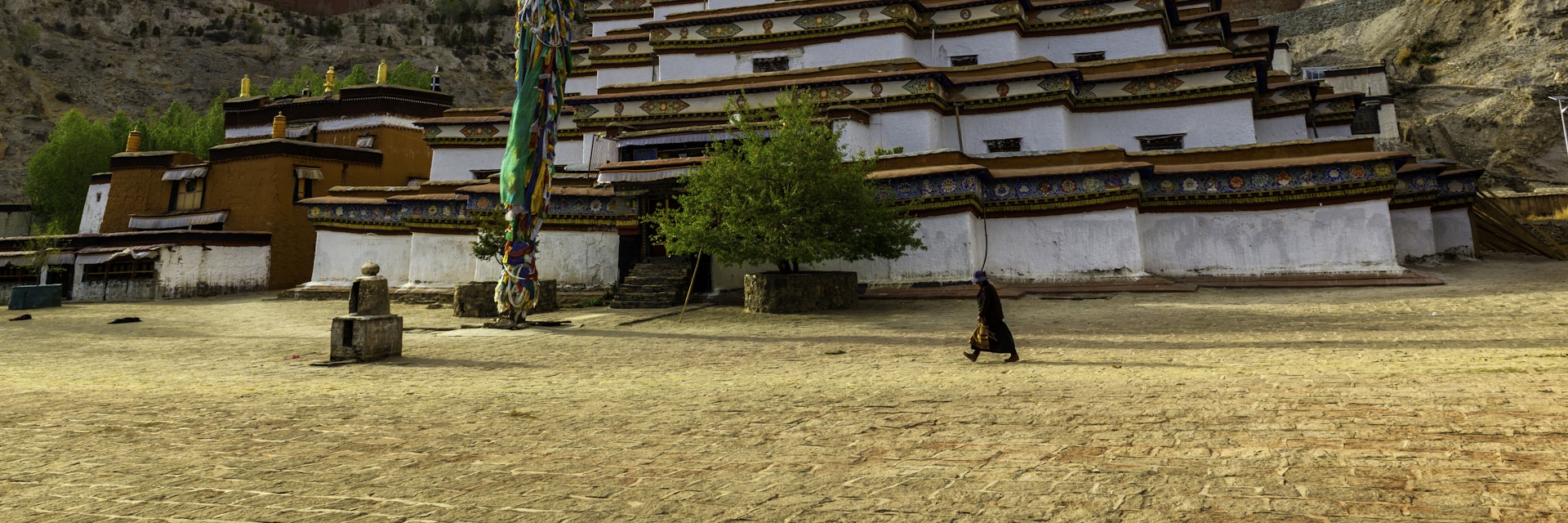Commissioned by a local prince in 1427 and sitting beside Palcho Monastery, Gyantse Kumbum is the town’s foremost attraction. This 32m-high chörten, with its white layers trimmed with decorative stripes and crown-like golden dome, is awe-inspiring. But the inside is no less impressive, and in what seems an endless series of tiny chapels you’ll find painting after exquisite painting (kumbum means ‘100,000 images’).
It costs a worthwhile ¥10 for photos (not included in the ticket, bring cash).
Gyantse Kumbum has been described as the most important of its kind in Tibet. There are only two contemporaries, both ruined, remote and off limits, in the Buddhist world: Jonang Kumbum, 60km northeast of Lhatse, and the even more remote Chung Riwoche, in the west of Tsang. However, it is commonly held that neither could ever compare with the style and grandeur of the Gyantse Kumbum.
Upon entering, follow a clockwise route marked by red arrows that leads murmuring pilgrims up through the six floors, taking in the dozens of tiny chapels that recede into the walls along the way. Much of the statuary in the chapels was damaged during the Cultural Revolution but the murals have weathered well. They date back to the 14th century, and if they were not created by Newari (Nepali) artisans then they were obviously influenced by Newari forms. Experts also see evidence of Chinese influence and, in the fusion of these Newari and Chinese forms with Tibetan sensibilities, the emergence of a syncretic but distinctly Tibetan style of painting.
The 1st floor has four main chapels, two storeys high, oriented according to the cardinal points. The four chapels are dedicated to: Sakyamuni (Sakya Thukpa; along with two disciples, medicine buddhas and Guru Rinpoche) in the south; Sukhavati, the ‘pure land of the west’ and home of red Öpagme (Amitabha) in the west; Marmedze (Dipamkara, the Past Buddha) in the north; and Tushita, another ‘pure land’ and home of orange-faced Jampa (Maitreya), in the east. In between are some excellent murals depicting minor Tantric and protector deities. Statues of the Four Guardian Kings in the east mark the way to the upper floors.
On the 2nd floor, the first four chapels in clockwise order from the stairs are dedicated to Jampelyang (known in Sanskrit as Manjushri), Chenresig (Avalokiteshvara), Tsepame (Amitayus) and Drölma (Tara). Most of the other chapels are devoted to wrathful protector deities, including Drölkar (White Tara; 12th chapel from the stairs), Chana Dorje (Vajrapani; 14th chapel) and Mikyöba (Akshobhya; 15th chapel), a blue buddha who holds a dorje (thunderbolt). You can only view the chapels on this floor through the doorway windows.
The 3rd floor is also dominated by a series of two-storey chapels at the cardinal points portraying the four Dhyani Buddhas: red Öpagme (Amitabha) in the south; orange Rinchen Jungne (Ratnasambhava) in the west; green Donyo Drupa (Amoghasiddhi) in the north; and blue Mikyöba (Akshobhya) in the east. There are several other chapels devoted to the fifth Dhyani Buddha, white Namse (Vairocana). Again, most of the other chapels are filled with wrathful deities.
The 11 chapels on the 4th floor are dedicated to teachers, interpreters and translators of obscure orders of Tibetan Buddhism. Exceptions are the Three Kings of Tibet on the north side (eighth chapel clockwise from the steps) and Guru Rinpoche (10th chapel).
The 5th floor, which is also known as the Bumpa, has four chapels and a fine mandala gives access to the roof of the kumbum. Most people are taken in by the outstanding views, especially looking south over the old town where, in the background, the white-walled Gyantse Dzong is perched atop a colossal outcrop. Hidden steps behind a statue on the eastern side lead to the 6th floor and take you onto the verandah at the level of the eyes painted on the wall (this floor was closed for renovation in 2018).
The top floor of the kumbum portrays a Tantric manifestation of Sakyamuni (Sakya Thukpa), but you will likely find the way up locked.


